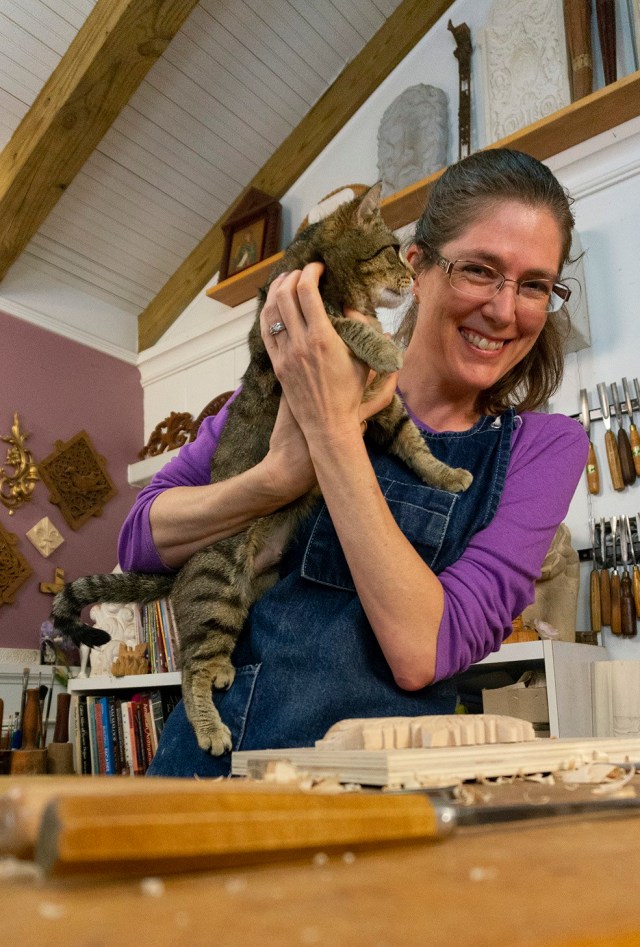
Perhaps the best way to describe Mary May, author of “Carving the Acanthus Leaf,” is to describe another woman – Grace. Grace began as an 8” x 10” x 21” block of mahogany, and emerged not with plan or intent, but with patience, skill and curiosity.
On her blog, Mary wrote about the process of carving Grace without referring to a model – a process called “direct” carving. “A woman was in there somewhere,” Mary wrote. “I just needed to begin chipping the wood away and find out where and who she was.”
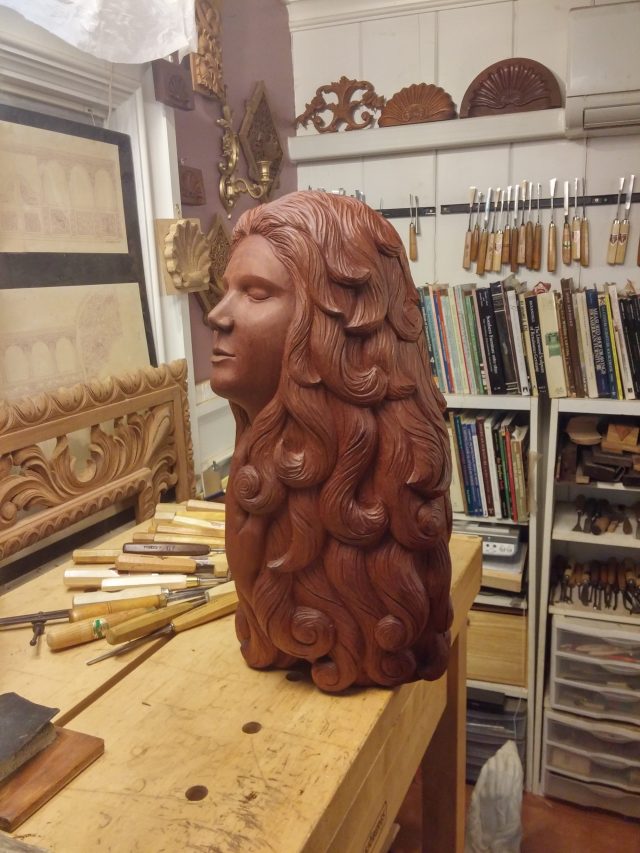
And so it is with Mary herself. A carver was inside her, always – that’s evident in her childhood stories of three-dimensional play and carved zucchini dolls. But just as Mary handled Grace, she has worked her way through life not with a grinder, but rather slowly, with a mallet and chisel. “Without having a specific design, how do you know what is ‘waste’ wood, anyway?” she writes when talking about carving Grace. “This process of slowly chipping away helped me to discover the design as I carved.”
And so it is with Mary’s life. Her life experiences have allowed herself to live three-dimensionally. In fact, her work these days is split in thirds – carving, teaching and creating online videos. And what has emerged is a well-respected career that has allowed her to fill her days doing exactly what she loves.
A Childhood of Fulfilled Dreams & Eccentricity
Mary was born in the Chicago area and grew up in the city’s suburbs until she was 11. Her dad was working as a systems analyst at a time when computer programming was still young. His commute into the city took two hours – each way. “He got really burnt out on that,” Mary says. Wanting to simplify, Mary’s dad quit his job and became an auto mechanic, a job he held for many years.
“What’s interesting is that my dad actually went to college for philosophy and theology,” Mary says. And her dad would argue that having studied both subjects made for a perfect combination for his newfound profession. “In his very unique mind it was the right combination of someone who could figure things out and solve problems,” Mary says.
Mary’s mom collected junk and sold it. “Our entire house was just filled with all sorts of collected things,” Mary says. “I had an interesting childhood. I thought it was a normal childhood, but now that I look back on it, it probably wasn’t.”
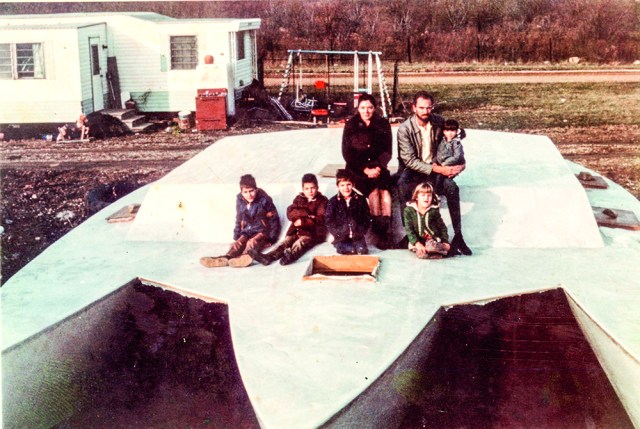
Mary grew up with three brothers and one sister, and their childhood was spent following the whimsy of their parents. Their father’s boatbuilding hobby is a good example.
“He built two different boats, one when I was 4 and the other when I was 11,” Mary says. Once the boats were built, the entire family lived on them. “The second time we were all teenagers – well, I was almost a teenager,” Mary says. “I can’t even imagine what my parents were thinking.”
Mary says her dad, who died in 2003, served in the Navy and she has often wondered if that played a part. He sought out adventure and regularly eschewed the traditional road.
“He was a quiet, normal-acting and -looking person,” Mary says. “But he just had this dream and he wanted to live it and nothing was going to stop him. It was quite an adventure. As a child, I probably didn’t appreciate it much. It definitely was something that was very valuable as to how we developed our way of thinking and of dreaming.”
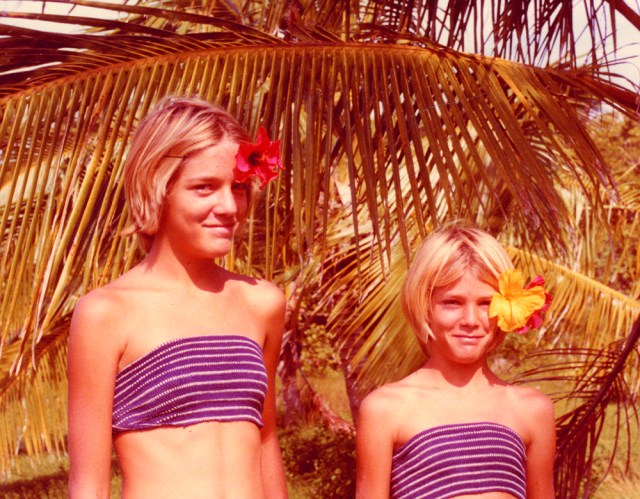
While on the first boat trip (they traveled the length of the Mississippi River and then sailed to the Bahamas) Mary says she and her siblings continued their education by taking correspondence courses through the mail. During the second boat trip they stayed in the Florida Keys for six months so the children could attend school.
“We were staying at a marina, anchored, and we were on a serious budget,” Mary says. The marina charged docking fees and utilities, but if your boat was simply anchored, there was no charge. So Mary and her siblings would pile into a rowboat and row themselves to shore every day to catch the school bus.
“My dad’s quiet way of living his dream had a real significance on my decision-making,” Mary says. “I think the main thing that I gained from it is other people may think your dream is odd and obscure, but if it’s your dream then go ahead and dream it and do what you can to achieve it.”
Mary’s family moved from the suburbs of Chicago to rural Wisconsin when she was 12. “It was a pretty drastic lifestyle change, living out in the country,” she says. When they first moved to Wisconsin they lived in a trailer they had previously used as a summer vacation home. For six months – including a Wisconsin winter – it was as if they were back on the boat, living in a trailer that had no running water. Mary says she remembers going to the neighbor’s house to fill up five-gallon buckets of water and carrying them home. “It was rough,” she says. After six months, they found a new place to live. “It had running water and was a little more civilized,” she says.
Mary lived in rural Wisconsin until she graduated from Sparta High School in 1985. “I really enjoyed the country,” she says. “I enjoyed the quietness of it. My parents were concerned with the influence that the city and the suburbs would have on us so they just wanted us to get out and experience the rural life.”
Learning to See in Three Dimensions
From a young age, Mary loved shaping three-dimensional things. And her mother’s collected junk gave her much to play with. She remembers shadow boxes that intrigued her, and Strawberry Shortcake wrapping paper, in particular. At 7 or 8 years old Mary remembers cutting out the little images of Strawberry Shortcake, making arms and sticking them on, adding dimension to what was previously flat. She became acutely aware of the closeness of things, the thickness of things, how objects could look farther apart and then appear closer to the background.
“I was interested,” she says. “It was a training ground. I started to view and visualize things, and I think that was a real plus. I don’t think my parents had a clue where that would lead me but it was interesting.”
She calls herself an obsessive child who had a tendency to latch onto projects. Once, while living on the boat, she asked her dad for all of the boat’s dimensions. She wanted to draw an exact replica of the boat, scaled down on paper. Her dad taught her how to use the scale ruler and she spent hours replicating the boat, every tiny detail – she was 11.
While Mary was surrounded by a lot of creativity growing up, compliments and encouragement were rare. “My dad, especially I think, was not a man of very many words and it was very hard to get any kind of response at all,” she says. “When he did encourage you, you thought, Wow. I’m going to grab and hold onto that one. They just expected us to succeed in whatever it was we were doing. They expected us to be good at whatever we did.”
Mary loved hanging out with her dad who was a hobby carpenter. One time, at the age of 12, she was out in the garage with her dad and told him she wanted to make a dollhouse. “My dad helped me get plywood and taught me how to use the scroll saw to cut out the windows and how to use the hand drill,” she says. “I made my first dollhouse and it was pretty rustic but it was mine. I think that was probably the first time I built something in wood. I sold it at a garage sale for $8.” She wishes she had kept it.
Mary began carving at a young age, although not in wood. In her book she tells a story about carving a pumpkin in Wisconsin (and also a delightful story about carving her name in her dresser). “I kind of always did that kind of thing,” she says. “We had huge zucchinis that would grow in the garden, beyond the point of being edible. I’d carve faces into the ends of them.” The necks of these dolls would weaken, turning the zucchinis into bobble heads. “I’d walk around with the bobble head and eventually it got so weak that the head would fall off and that was pretty traumatic.”
The Art of Making the Complex, Simple
Mary attended college for two years, but was undecided about her future. She took a class in ceramics that she loved – because it was three-dimensional. She knew she wanted a career in art, but she hadn’t yet discovered carving wood, specifically. And the idea of living her life as a starving artist offered little appeal.
During her second year of college Mary studied abroad in London. “That’s when I ended up absolutely falling in love with stone and wood carvings,” she said. Now, when she looks back at the photographs during her time abroad, she sees a theme – photo after photo of carvings and architectural details from the insides of churches and cathedrals. “It’s interesting to look back to see what you gravitated toward and what you didn’t,” she says. “You can look back and kind of locate those things.”
Mary wasn’t a good student. “I didn’t take notes very well,” she says. “I would take an entire page of notes where I would make everything three dimensional with the letters coming off the page. I never paid any attention to what the teacher was saying, but I would have pages of these very bizarre, three-dimensional notes.
Feeling like she wasn’t heading in any specific direction and not wanting to spend more money, Mary dropped out of college and enrolled at a technical college. For two years she studied desktop publishing – what is now called graphic design. “I ended up working at the school that I studied at as a desktop publisher,” she says. Her job was to assist tutors and redesign old, worn-out, hand-drawn and handwritten instructional packets. Think: a manual teaching someone how to change a tire.
“I think that really, really helped writing my book,” she says. Mary wrote “Carving the Acanthus Leaf” with a layout in mind. And although she’s never studied teaching, designing instructional packets at the technical college required her to think as a teacher would. “What I try to do is remember back to when you first start doing something,” she says. “I really try to get into their heads and into their position of being a beginner.”
There’s an art to making the complex seem simple, and it’s an art Mary excels at, as is evident not only in her book, but also in her classes (ask any of her former students) as well as her instructional videos. Her goal, when teaching in person, on video or on paper, is to take out any possibility of misunderstanding while also creating an increased interest in the work, all the while crafting a simple explanation of what actually is a complex idea and design.
Creating a Career Out of Carving
Mary began carving while working at the technical college. She bought a beginning woodcarving book at a garage sale, a large curved gouge and a rubber mallet. Her workshop was in her bedroom. It was during this time that she started taking classes two nights a week with a Greek master carver named Konstantinos Papadakis.
“The more I started to carve, the more I was attached to it,” she says. “I couldn’t get away from it. Even when I was at my job and trying to do these learning packets, I was constantly thinking what I wanted to carve. I think it just became an obsession.”
And this is why Mary was so happy to be laid off from her job with severance pay. “I was really trying to figure out how to do the carving full time and I couldn’t come up with a way to do that and be a responsible citizen,” she says.
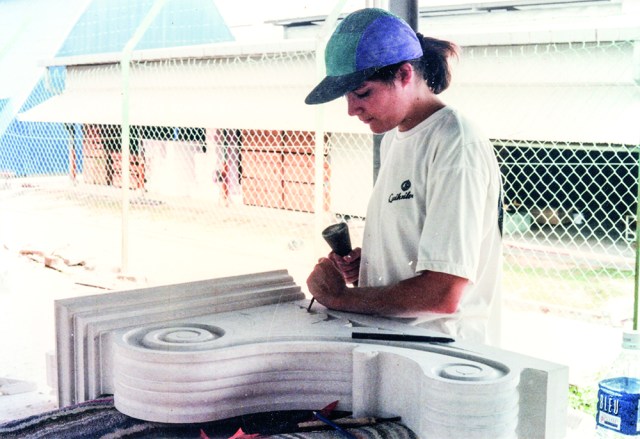
She traveled to Athens, Greece, this time to Theofanis Andravidiotis’s studio, where she worked alongside master Greek carvers and their apprentices. From there she traveled once again to London, where she attended City & Guilds of London Art College, studying traditional carving designs and techniques. She also did a stint working as a stone carver in Malaysia. (You can read much more about all of this in her book.)
While Mary loved the training, she said she did have to go through a bit of a punishing period where you had to prove yourself. And then she fast-forwards for a moment, mentioning how often people want to become a master carver after taking one week-long class. “It’s difficult to convince people you’ll need a little bit more time,” she says. “You have to put in the time.”
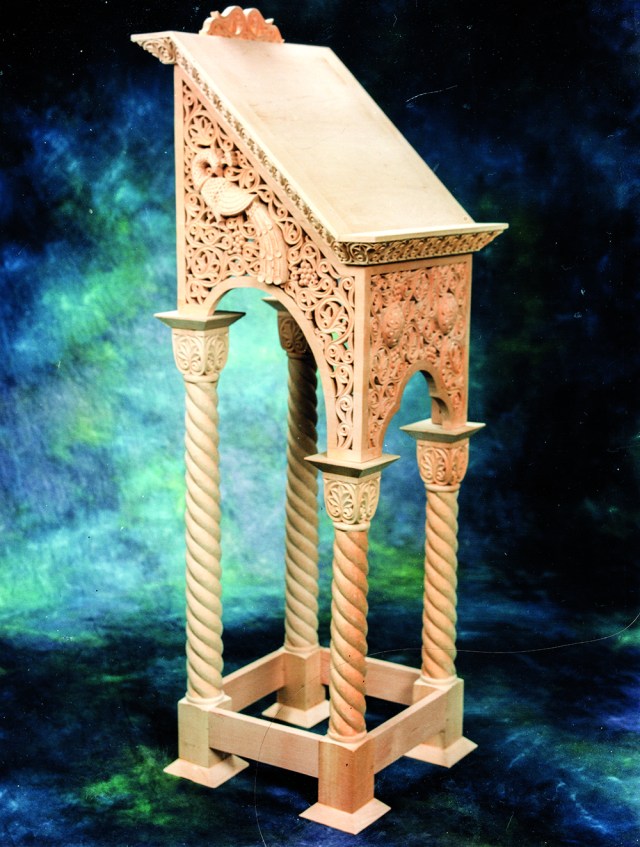
When living in the states, work, at times, was sparse. Mary would do occasional sign carvings as well as spec pieces, including the Byzantine-style icon stand featured in her book. Mary found it difficult to get her name out, and difficult to prove to people what she could do. So she simply continued working on her skills and techniques until a man she was dating convinced her to move down to South Carolina. “That’s when the work really started to open up because of the area and the historical significance in Charleston,” she says.
In South Carolina, after some time, Mary found lots of work repairing and restoring furniture, as well as working on new homes along the coast. But the work wasn’t immediate. The key was convincing people of what she could do. Many builders and homeowners didn’t realize, for example, that a hand-carved fireplace mantel was a possibility. So Mary had to put herself out there, presenting herself in a way that was starkly different from the person she used to be.
“I was actually a very shy person,” Mary says of her childhood self. “I think there was a big part of me that needed to get over my shyness to function in the world. I had to force myself to get out there and go traveling. And I did a lot of traveling on my own and forced myself to get out and interact with people. It helped me through that – when you realize if you want the chance to live a successful life, you kind of have to get past that.”
Mary’s also tough. She circles back to her childhood, to the six months she lived in a trailer with no water. “I knew I could survive in pretty sparse living conditions,” she says. “I was willing to do that [again], to put up with whatever came my way, to live as frugally as possible, to take on a second job, to take on another real job – fortunately I never had to do that then.”
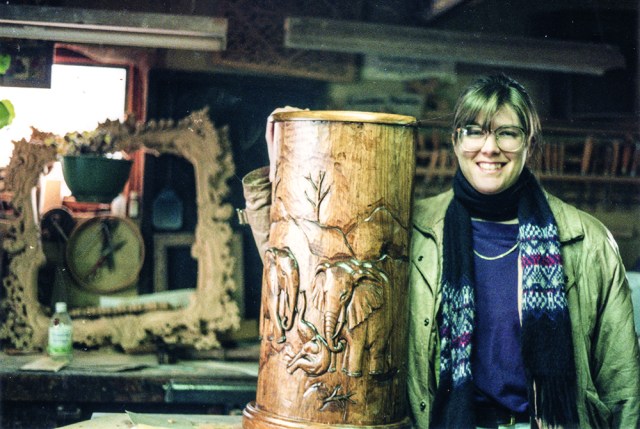
After finally landing in a comfortable place of steady work doing what she loved, Mary did have a concern. If this was something she was passionate about and loved to do, what would happen when it became her career? Would she lose the passion once her hobby became her business? Her concern, it turns out, appears to be unfounded. “Twenty-seven years later I still absolutely love it,” she says.
“An Enjoyable Adventure”
Flexibility and creativity have been important to Mary’s success. “There are times when I don’t have a lot of commissions, when I don’t have a lot of work, and I have a lot of time to think and get creative,” she says. “[I think:] I want to continue to do this as my job. How else can I look at this? Maybe I can go this direction, maybe I can do teaching, start an online video school. And that’s how I started the online school. I didn’t have a lot of work six years back and I wanted to keep doing this. But how?”
The key, Mary says, is to not get burned by doing one thing and one thing only way too long. “It becomes repetitive,” she says. “You get burned out. With the variety that comes with my work there are very few times when that happens.”
Mary still lives in South Carolina, but not with the man who initially convinced her to move down south. (There is a lovely story about how she met her now-husband, Stephen, in her book.) For the last 16 years she and Stephen have lived on a couple acres in the country on St. John’s Island.
When they bought their home, it was falling apart. “The person who built it was about 4’11”, and all the ceilings were short,” she says. “He basically built it to fit his height.” So Mary and Stephen, who works as a private contractor, completely redid the house. “It was a fun process,” Mary says. “My husband did a lot of the restoration and renovation. We only have a few items in the house that I actually carved. It’s really like the cobbler’s house.”
And whenever Stephens’s work was slow, he would work on Mary’s workshop, every couple of years adding another extension. “It’s a beautiful little workshop,” she says.
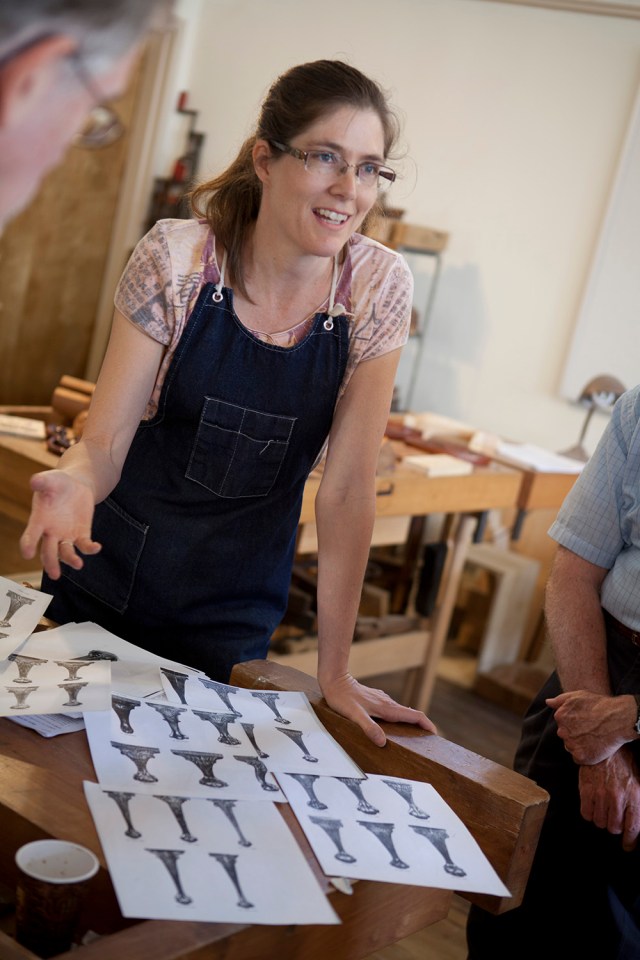
These days, Mary’s work consists of teaching, at different locations and occasionally in her workshop, working on her online videos and working on commissions. Last year, finishing up her book added another layer of work on top of her busy schedule – she found herself up until midnight, 1 a.m., 2 a.m., sometimes 3 a.m., every night plus weekends. “I’m still recovering from that,” she says. The work did, however, prompt her to take a one-week-long cruise with her sister. “Then my sister convinced me to do a back-to-back cruise, so we did another week and it was very irresponsible. It was one of those things I used to do before I was married.”
Her days are often similar. The mornings are reserved for computer work. She helps Stephen with his bookwork, does his invoices and catches up on email. Then she heads out to her shop to work on her commissions. “Sometimes I can spend 5 hours or 10 hours a day, depending on how critical the deadline is,” she says. “Occasionally, if I’m working on a commission, I like to video it so I can include that as a project and a lesson on my online school.”
She’s not good at taking breaks. “I sort of forget and five or six hours later I realize that I haven’t stopped,” Mary says. “But it’s funny because I had some students here taking classes and at 10 a.m. in the morning they wanted to take a break and I was like, ‘What do you mean?’ And they asked, ‘Where are some chairs to sit in?’ And I said, ‘Chairs? What do you mean? We don’t have any chairs around here.’ And I realized, oh my goodness, I don’t stop. So I went to the Dollar Store to buy some chairs so they could sit and take a break.” She laughs.
Filming her work requires three cameras, all of which are set up in her workshop. “They’re just on tripods,” she says. “I’m pretty much here by myself.” She likes it that way. She has a computer in her shop and because she’s by herself, she says she can take as many takes as she wants. “When I mess up I don’t have to waste anybody else’s time,” she says.
Mary’s oldest stepson, Caleb, is her video editor. “He’s the one that makes me look good,” she says. “He did say he’s saving all the bloopers. I’m not sure what I’m going to get, a blooper reel? He takes all of them and he does a great job of making sure whatever camera angle is correct and zooms in and it’s all pretty much real time. It’s in-house. I do the videos and Caleb does the editing. We keep very busy with that. We do a video every week. It’s going really well. There’s a lot of interest and I’m excited to see a lot of beginners get into that.”
When asked about her hobbies, Mary says she enjoys gardening but she’s not very good at it. “I’ve been asked, ‘What do you do for fun?’ And I’m like, I have to think of something clever. The first thing I thought of was carving. ‘What do you do for fun?’ My career. I thought it was sort of the best answer I could give. I really couldn’t think of anything else.”
She still loves to travel. “We’re kind of homebodies here,” she says. “But I like to travel and I hope to travel a lot more. My husband likes to come with me occasionally when I teach in different locations.”
And thinking both in terms of flexibility and creativity, Mary has been considering a new idea – a mobile workshop, that would allow for travel, videos on the road, interviews and workshops in different parts of the country. “If I have too much time on my hands, I can see different ways to steer it,” she says.
Mary finds satisfaction in all her work’s dimensions. “Carving itself is very enjoyable and I get to lose myself for hours,” she says. “There’s a different type of satisfaction when you’re teaching. And there’s still something different of just being able to share – other people get just as excited. I get the occasional email from students and I’m thrilled with what they’ve done. I love that part of it.”
When looking back on her life thus far, Mary gives God a lot of credit. “I acknowledge that God gives us gifts and I think you need to realize where the gifts come from and my gifts do come from God,” she says. “I think ultimately life is a challenge but you can take those challenges on and actually turn them around as an enjoyable adventure. I think that’s probably how I have survived as many years as I have doing what I really love to do.”
— Kara Gebhart Uhl